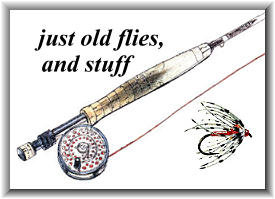This salmon fly, fanciest of the fancy, was named
after its creator, Wakeman Holberton, of New York
City. It had an orange body ribbed with gold
tinsel, head of peacock herl, with hackle of the same,
mixed with purple and a wood duck tail. The wings
were duble. The under wing coverts were
scarlet ibis, mixed with mallard feathers dyed yellow.
The outer wing coverts were of wood duck, with two
long rays of peacock herl.
Mr. Holberton was an excellent caster in the competitions
of the New York State Sportsmen's Club. As an artist his
trout picture, "Speckled Trout," "The Rise," "Struggle"
and "The Death" won great acclaim. He was secretary of
the Neversink Club in 1884, which club on the West Branch
when had a creel limit of twenty-five (25) and size limit
of six (6) inches.
In 1882, Mr. Holberton, claiming that there had been a lack
of any standard to which anglers could refer with confidence
and rely upon to tell them exactly the forms and colors of
the different names flies, and to avoid the confusion of
the same fly bearing different names, painted fifty copies
of a water color picture, showing a speckled trout rising
to a fly. Surrounding the trout in the form of a border
are sixty-four trout fly patterns, numbered and named.
The picture, measuring 15 x 22 inches, is entitled "Standard
American Trout Flies." The writer [Harold Hinsdill Smedley]
knows of and has seen but one copy; that is No. 6, owned
by Edward D. Knight, Jr. of Charleston, West Virginia.
As a result of his twenty-five years of fly fishing, he also
attempted to, and did, classify them in three classes, A-B-C.
A represented those that had proved most killing; B, not quite
to good; C, occasionally good. Some from his list are
listed herein as follows:
A Coachman, Shoemaker, Abbey, Grizzly King.
B Queen of Water, Professor, Beaverkill, Cahill, Montreal
C Hooker, Bee
In 1884 he painted a set of fourty varieties of "Standard
American Black Bass and Lake Flies."
He was the author of The Art of Angling,
1887; and Angling Recreation, 1889 - a
single volume issue, with painting by himself. When
writing for the papers, which he frequently did, he
often used the non de plume of "Scarlet Ibis."
The bass fly "Lottie," a yellow and black fly also
originated with Mr. Holberton.
The Holberton as tied in Forgotton Flies:
Tag - Gold tinsel.
Tail - Barred mandarin, crimson, yellow, peacock sword.
Body - Rear half orange flosss, front half peacock herl.
Ribbing - Gold tinsel.
Wing - Peacock sword, crimson, yellow, and barred mandarin.
Eye - jungle-cock.
Credits: Text from Fly Patterns and Their Origins,
By Harold Hinsdill Smedley, photo from Forgotten
Flies.
|



